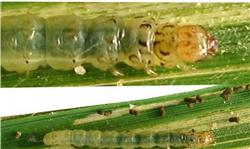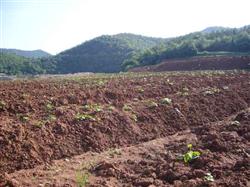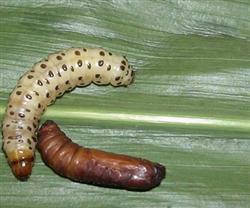What should be paid attention to in the control of rice leaf roller?

What should be paid attention to in the control of rice leaf roller? Please give guidance on the control of Cnaphalocrocis medinalis, first of all to know the control time. The control time is determined through the progress of insect state development and the growth and decline dynamics of adults under the lamp, referring to the insect state calendar, combined with medium-and short-term weather forecast. In order to ensure that we can really grasp the appropriate period of control, we must understand the damage characteristics of the larvae. The 1st instar larva is the "white spot stage", climbing into the heart leaf or the inside of the young leaf sheath at the tillering stage, and at the booting and heading stage. The second instar larva is the "bundle tip stage", which can roll the leaf tip into a small insect bud, and the larvae can hide inside the insect bud. The 3rd instar larva is the "waist-binding stage", which can roll the middle of the leaf into a longer bract to form obvious white leaves; the 4th instar enters the "bract turning stage", the larvae frequently turn to the bud harm, and the white leaves gradually increase; the 5th instar enters the "overeating stage". The damaged leaves were withered and white, and the whole paddy field was full of white leaves, and the 4th and 5th instar larvae accounted for more than 90% of the total food intake. In order to achieve the best effect, the rice leaf roller is controlled from the peak period of egg hatching to the first peak stage of low instar larvae. However, we often find that many farmers do not control the prevention and control time at will, because there is a certain difference in occurrence time between years and years, the control time is different every year. Therefore, if the pesticide is not applied in time within the appropriate period of control, and when the white leaves are seen in the field, the rice leaf roller larva has entered its advanced age, and the control effect has declined. In the end, there is no doubt that the loss outweighs the gain. To control Cnaphalocrocis medinalis, it is necessary to know the control object. Only when we understand the object of prevention and control, can we have a clear target. The occurrence of rice leaf roller is closely related to climatic conditions. under the condition of suitable temperature and high humidity, it is beneficial for adults to lay eggs, hatch and survive larvae. therefore, the weather of suitable temperature, rainy days and high humidity with more dew is beneficial to the occurrence of rice leaf roller. Adults have phototaxis and tender greenness, like shade and damp, and can migrate for a long distance. Only by understanding the life habits and harmful characteristics of rice leaf roller, can it be convenient to "prescribe the right medicine" and establish the key objects of prevention and control. To control the rice leaf roller, the third is to master the control agents. Judging from the remarkable results of rice pest control in this city in recent years, the ideal insecticides for the control of rice leaf roller can choose environmental protection pesticides with high efficiency, low toxicity and low residue, such as Kangkuan, Daoteng and Longge. Kangkuan, that is, 20% chlorobenzamide suspension, is a stomach poison and contact pesticide, with a dosage of 10 ml (2 packets) per mu, evenly sprayed with water stems and leaves, and 30 kg of water per mu (depending on rice growth and insect conditions, as appropriate). If it occurs again (severe generation overlap), spray it again every 15 days. Daoteng is a 10% suspension agent, which is a mixture of 6.7% fluorobisamide (developed by Nippon Pesticide Co., Ltd.) and 3.3% avermectin. Its main way of action is stomach toxicity and contact killing, the safe interval used in rice is 28 days, and the maximum application time is 2 times per growing season; Rongge is 20% fluorodiamide water dispersible granule, which is mainly stomach toxicity and has a certain contact killing effect. The residual period is long, and the pesticide is applied to control rice borer from egg incubation to young larvae, 2 to 3 times per season, and the interval is about 30 days. Prevention is the first, comprehensive prevention and treatment. Only by knowing the time, knowing the quantity and prescribing the right medicine for the control of rice leaf roller can we make the healthy growth of rice, promote grain production and increase farmers' income. Click to get more Pesticide Application techniques click to get more Pesticide Application techniques click to get more Rice planting techniques
- Prev

What should we pay attention to when planting kudzu root?
What should we pay attention to when planting kudzu root? Please give an introduction to the planting of Pueraria lobata should pay attention to the following points: 1. Site selection: Pueraria lobata has strong adaptability and lax requirements for land conditions, but the sandy red loam with deep soil layer, fertile soil and good drainage is the best. 2, land preparation: general dry land, ploughing about 33 cm, broken rake flat soil.
- Next

How to control ginger blast and ginger borer?
How to control ginger blast and ginger borer? Please introduce the control methods of ginger blast and ginger borer can refer to the following methods for control: first, ginger blast. The disease, also known as ginger rot, is the most common destructive disease in ginger production, and it is also the main factor restricting the production and quality of ginger. In recent years.
Related
- Fuxing push coffee new agricultural production and marketing class: lack of small-scale processing plants
- Jujube rice field leisure farm deep ploughing Yilan for five years to create a space for organic food and play
- Nongyu Farm-A trial of organic papaya for brave women with advanced technology
- Four points for attention in the prevention and control of diseases and insect pests of edible fungi
- How to add nutrient solution to Edible Fungi
- Is there any good way to control edible fungus mites?
- Open Inoculation Technology of Edible Fungi
- Is there any clever way to use fertilizer for edible fungus in winter?
- What agents are used to kill the pathogens of edible fungi in the mushroom shed?
- Rapid drying of Edible Fungi

